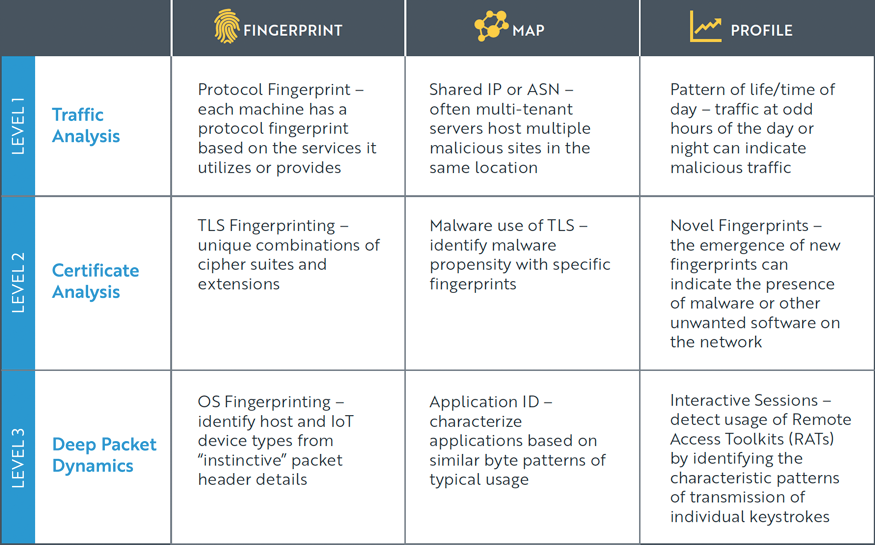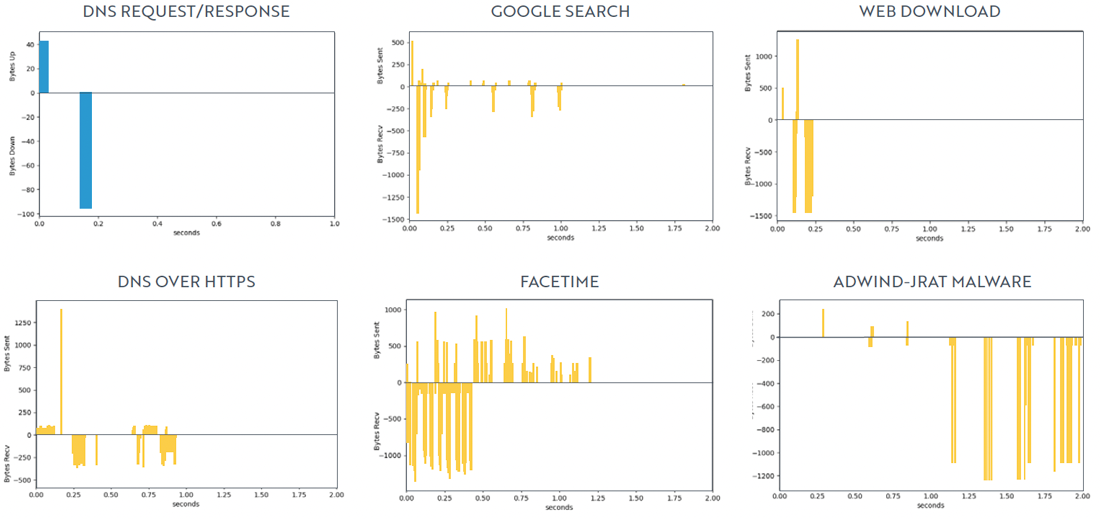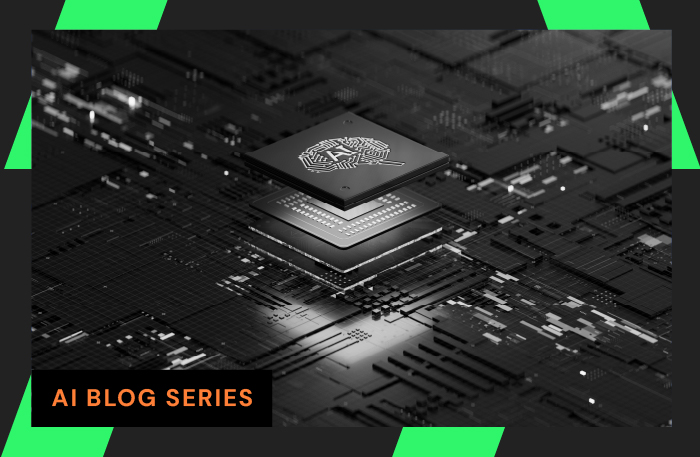Contents
- Security use cases
- Detecting phishing attacks
- Uncovering data exfiltration
- Discovering lateral movement
- Revealing anomalies
- Determining DNS/IP reputation
Tidy data is a powerful tool for network traffic analysis. In this paper, Live Action Chief Data Scientist Andrew Fast, explores the topic and its cybersecurity applications.
Introduction
The amount of encrypted traffic on the network is at an all-time high. Back in 2019, more than 70% of all network traffic was being encrypted, hiding critical information from network defenders1. Now that number is nearly 90% and encryption levels are still increasing. Previously, defenders had access to both the content and server information of email and webpages. Now, the widespread adoption of HTTPS and rapid deployment of encrypted protocols such as DNS over HTTPS and TLS 1.3 is greatly decreasing visibility into server identity and content. Without these sources of security information, the next frontier for network defenders is applying cryptanalysis techniques and machine learning for traffic analysis. LiveAction’s ThreatEye NDR platform combines these two techniques to provide visibility into “hidden” patterns within the communication itself. In this paper, we will explore how this can work and look at some advanced threat detection use cases.
Cryptanalysis
Derived from two Greek root words, “Cryptanalysis” (CRYPT – hidden, ANALYSIS – loosen) is the investigation of the hidden aspects of communication systems. Historically, there are two kinds of cryptanalysis: breaking the encryption itself and side-channel analysis of potential information “leaks”. Encrypted traffic analysis is a type of side-channel analysis that allows network defenders to do their jobs while maintaining the privacy and network integrity provided by a fully encrypted system. ThreatEye provides three levels of Encrypted Traffic Analysis:

Encrypted Traffic Analysis to Uncover Command & Control (C2) Activity
Malicious threat actors and malware system operators communicate with infected target systems using a set of techniques called Command and Control (C2). To avoid detection, C2 techniques are designed to mimic normal, benign traffic using common ports2 and standard encryption protocols3. Despite these precautions, Encrypted Traffic Analysis with machine learning is effective at uncovering different types of C2 activity.
- Level 1 Defends Agains: Beaconing
Beaconing is used by an infected system to reestablish contact with the control infrastructure. This activity is characterized by sending identical messages at a specified interval. When repeated messages surface, Level 1 ETA recognizes potential beaconing activity by capturing patterns within both the communication intervals and the byte totals in both directions. - Level 2 Defends Against: TLS Fingerprinting
The encryption software libraries used by malware often differ from the encryption libraries used by browser, apps, and other legitimate software. When beaconing activity identifies a suitable command host, an encrypted C2 protocol initiates a secure connection using these same libraries. These events create a distinctive signature that can be identified on the network.4 - Level 3 Defends Against: Sequence of Packet Lengths
Once a secure connection is made, communication between the C2 infrastructure and the infected target begins. Due to the specific nature of the C2 commands, the number and size of the packets being exchanged over this connection often have characteristic signatures that distinguish them from typical web traffic.5 Here, real-time analysis of packet traits like these can yield signature deviations that point to C2 activity.
In summary, ETA combined with machine learning techniques effectively identifies malicious C2 activity on the network. Despite having no visibility into the content of the exchange, ETA tells us a great deal about encrypted traffic and provides valuable insights to aid network defenders.
Defending Against Exfiltration with Encrypted Traffic Analysis
Once a threat actor has identified information of value, he or she must find a way to transport that data back to home base. Because bulk transfers of large amounts of data are readily detectable, attackers use other, less detectible techniques to exfiltrate data.
- Level 1 Defends Against: “Low and Slow”
Rather than exfiltrating the data in a single transfer, threat actors can choose to release small amounts of data over time6. Basic traffic analysis recognizes this “low and slow” technique by tracking byte totals over time. - Level 2 Defends Against: Tunneling
Tunneling encapsulates one protocol—or layer—of encryption within another one. This type of traffic has a different packet dynamic profile compared with standard traffic on that port. ThreatEye’s parsing capabilities can even detect nested layers of encryption7. Some forms of tunneling, such as DNS tunneling, are also detectable by analyzing the ratio of bytes being transferred in each direction during a connection. - Level 3 Defends Against: Cloud Service
Each cloud application has a highly recognizable packet dynamics fingerprint tied to its typical usage. Because exfiltration to a cloud-based account requires extensive data transfer, profiling typical usage for that user or IP8 can highlight whether or not a certain exfiltration is from the enterprise’s normal activities or the work of a possible threat actor.
Here again, Encrypted Traffic Analysis, coupled with machine learning capabilities, evaluates complex data patterns over time and highlights which activities grade as normal (potentially benign) or abnormal (potentially malicious)—all without access to the content of the data being transferred.
Cryptanalysis Techniques for Encrypted Traffic Analysis
We group cryptanalysis techniques for ETA into three main categories:

Example ETA Techniques

Deep Packet Dynamics vs Deep Packet Inspection
Deep Packet Dynamic (DPD) data supplied by ThreatEye’s probe software provide reliable security information that is useful for evaluating both encrypted and unencrypted traffic. In contrast, legacy visibility solutions identify relevant data using Deep Packet Inspection (DPI) which only works for unencrypted or clear text protocols such as HTTP. For encrypted traffic, DPI requires a decryption proxy, or middle box, to be deployed. Middleboxes can be costly, introduce performance bottlenecks and create additional security concerns.
The need to transition from DPI to DPD is underscored by the recent, rapid adoption of the HTTPS standard for the majority of Internet traffic. Previously, security practitioners would apply DPI techniques to unencrypted HTTP traffic to identify critical session details such as browser user agent, presence of a network cookie, or parameters of an HTTP POST. As web traffic moves from HTTP to encrypted HTTPS, network defenders are losing visibility into those details. Deep packet dynamic data (such as SPLT9) provides similar insights without the need for payload inspection. By relying on intra-flow visibility with full packet accounting, Encrypted Traffic Analysis can identify characteristics of HTTP flows and distinguish between malicious and benign traffic without decryption.
Analyzing deep packet dynamics both increases the amount of data produced for each flow and makes it more difficult to separate important network signals from noise. To address this challenge, ThreatEye includes a proprietary machine learning engine to apply statistical and machine learning models at the point of collection, allowing it to identify complex intra-flow patterns as the data are arriving. ThreatEye analyzes data across multiple flows and seamlessly integrates this data with its machine learning engine. This combination—streaming ML + rich DPD features—is unlocking visibility for network defenders at a time when legacy techniques offer fewer and few insights into encrypted traffic.
DPD Illustrated
Similar to a conversation between two people, DPD (here, SPL) capture the back and forth between two Internet hosts, giving us important clues about the encrypted communication.

Sequence of Packet Lengths (SPL) highlighting Packet Dynamics of popular web applications.
The Future of Deep Packet Dynamics
Network visibility is eroding as adoption of encrypted protocols increases. Encrypted Traffic Analysis addresses the loss of visibility by providing alternative techniques for network defenders to gain insight into network behavior despite the encryption, while protecting user privacy. Combining Deep Packet Dynamics with machine learning is the latest advance in ETA. This combination is revitalizing classic approaches to cryptanalysis by applying powerful algorithms to identify patterns in network data and can scale to address the continued growth in network traffic and the increased adoption of encrypted protocols.
Resources
- https://www.nsslabs.com/press/2019/7/17/nss-labs-announces-2019-ngfw-group-test-results/
- MITRE ATT&CK Commonly Used Port – https://attack.mitre.org/techniques/T1043/
- MITRE ATT&CK Standard Cryptographic Protocol – https://attack.mitre.org/techniques/T1032/
- Hiding in Plain Sight: Malware’s Use of TLS and Encryption, Blake Anderson, Cisco, January 2016
- Detect Malicious Communications Even Under TLS, Anton Tyurin, Positive Technologies, November 2018
- MITRE ATT&CK Data Transfer Size Limits https://attack.mitre.org/techniques/T1030/
- MITRE ATT&CK Multilayer Encryption https://attack.mitre.org/techniques/T1079/
- MITRE ATT&CK Transfer Data to Cloud Account https://attack.mitre.org/techniques/T1537/
Download White Paper
How ETA Works: Encrypted Traffic Analysis
About LiveAction®
LiveAction provides end-to-end visibility of network and application performance from a single pane of glass. We provide enterprises with confidence that the network is meeting business objectives, full network visibility for better decisions, and reduced cost to operate the network.




